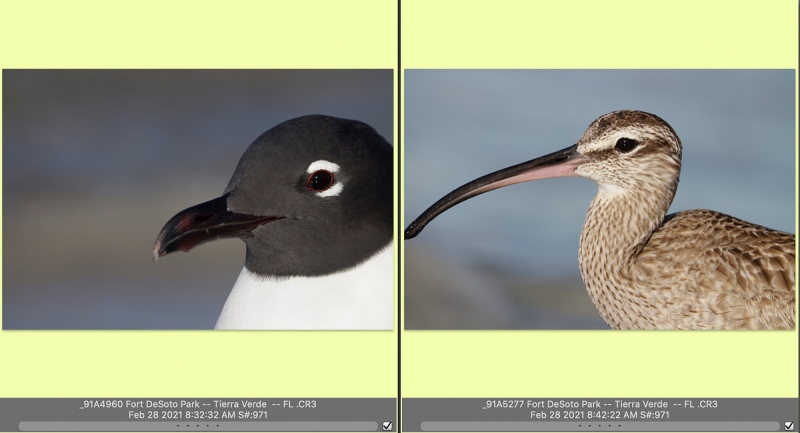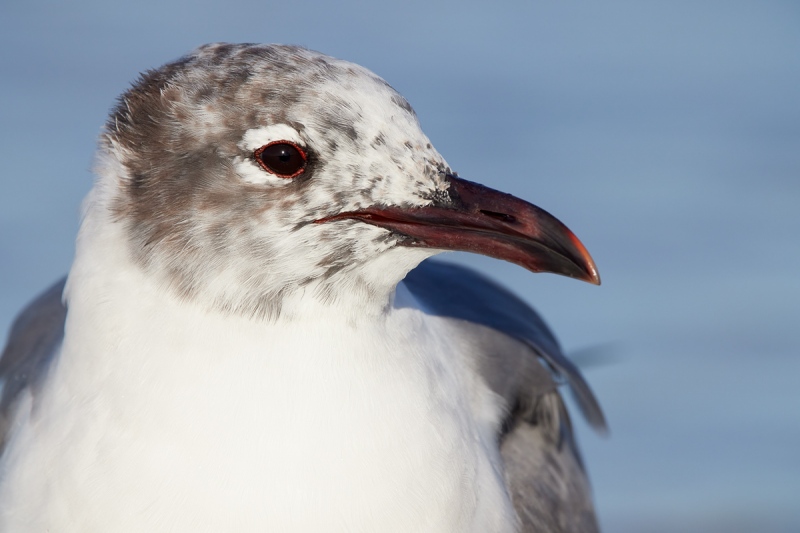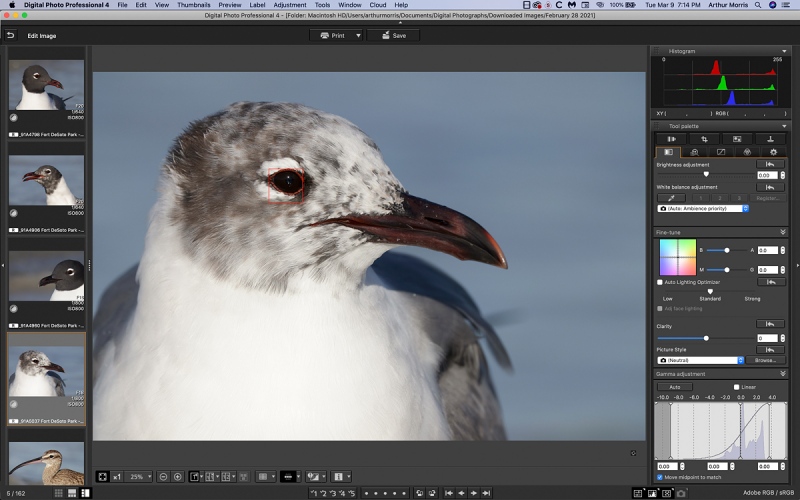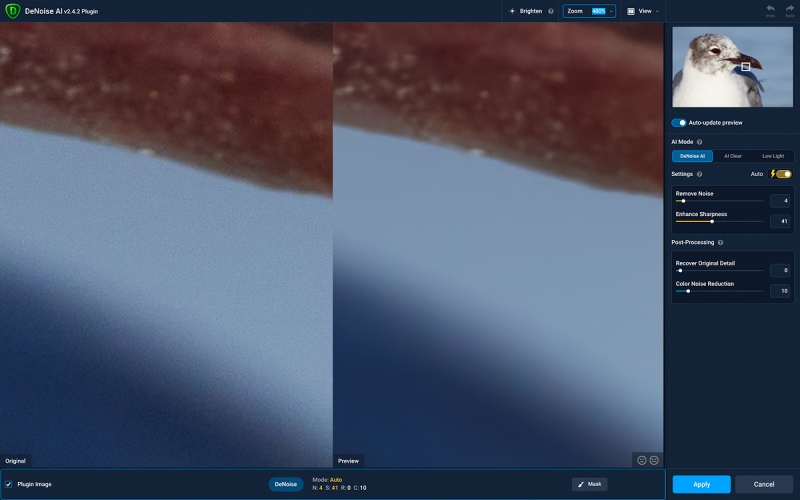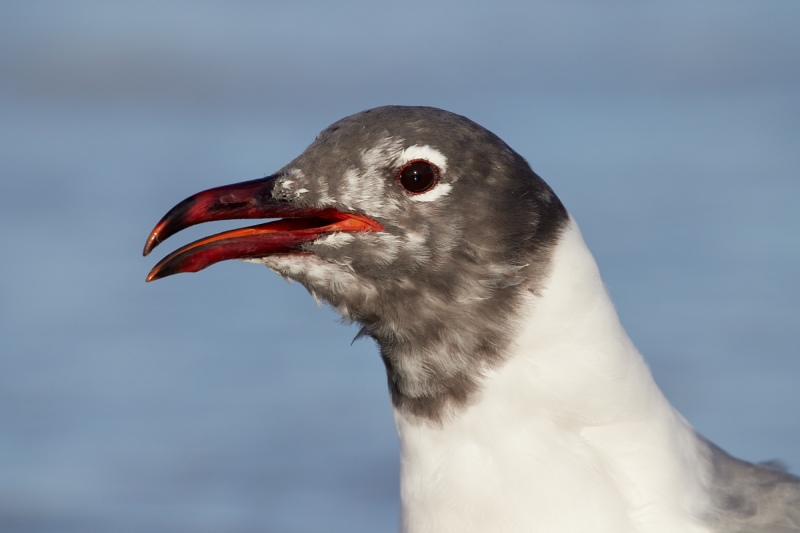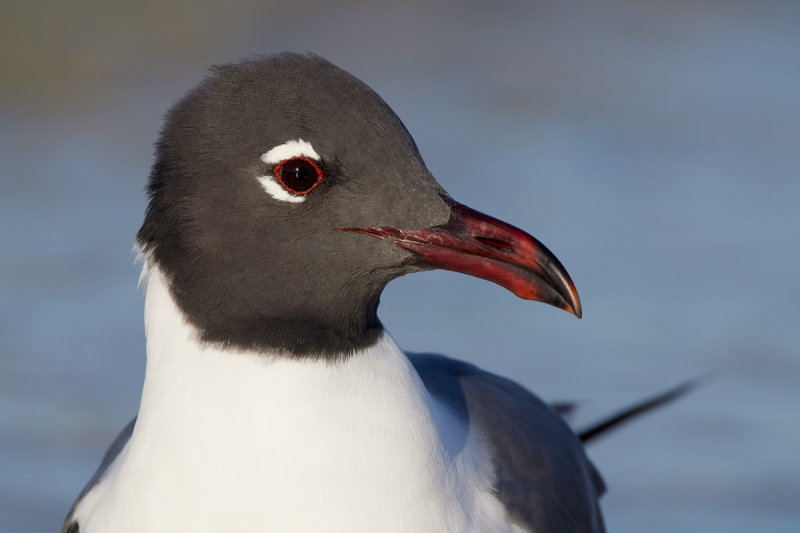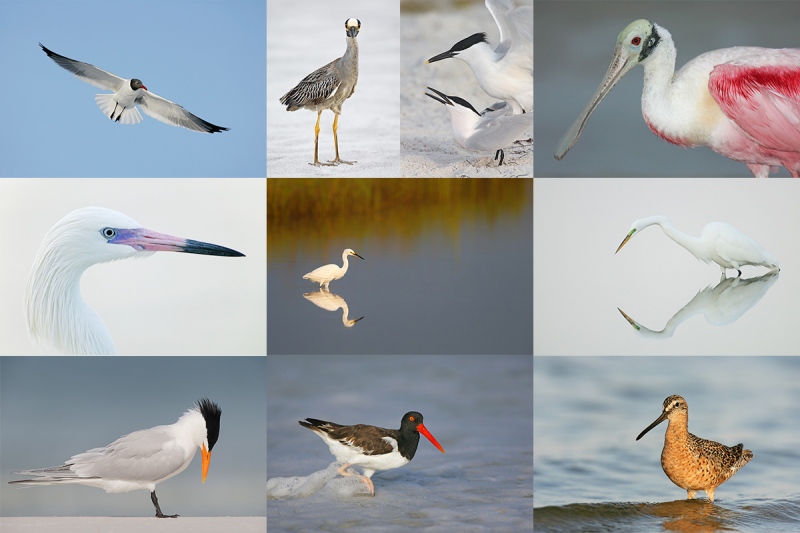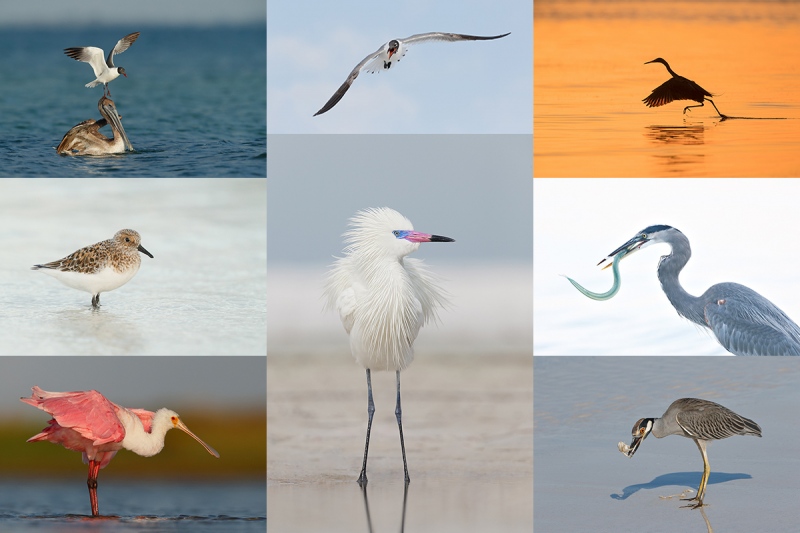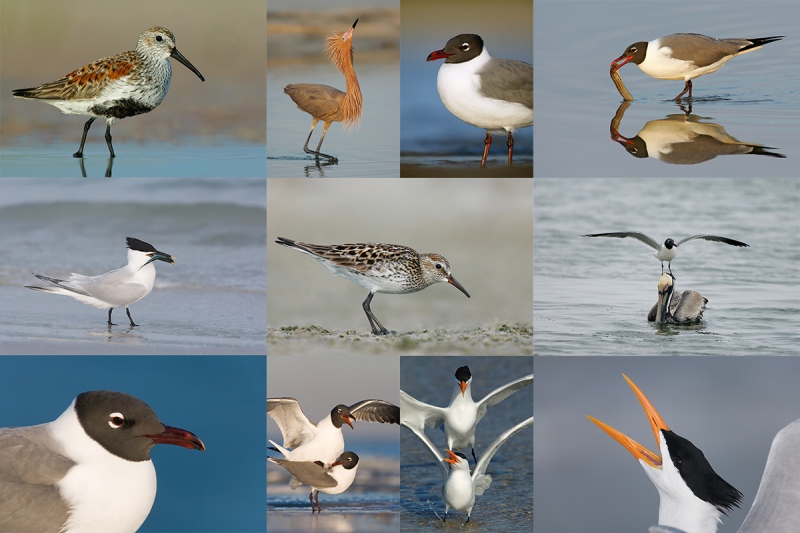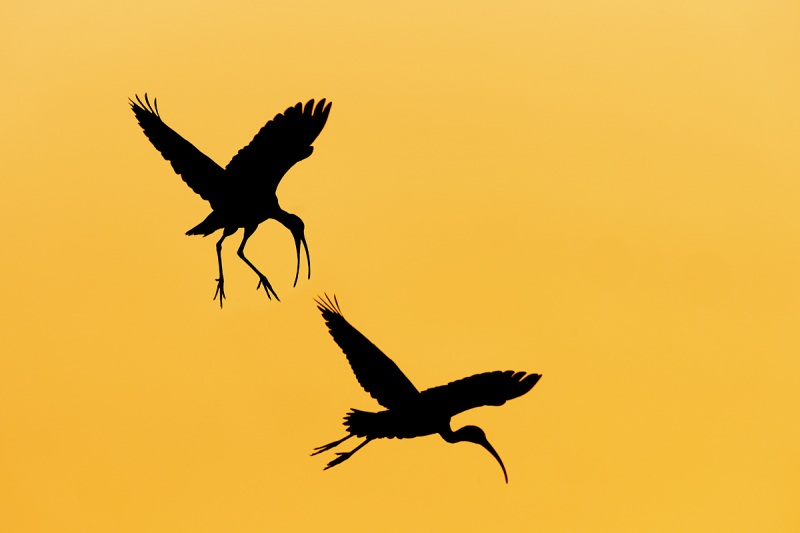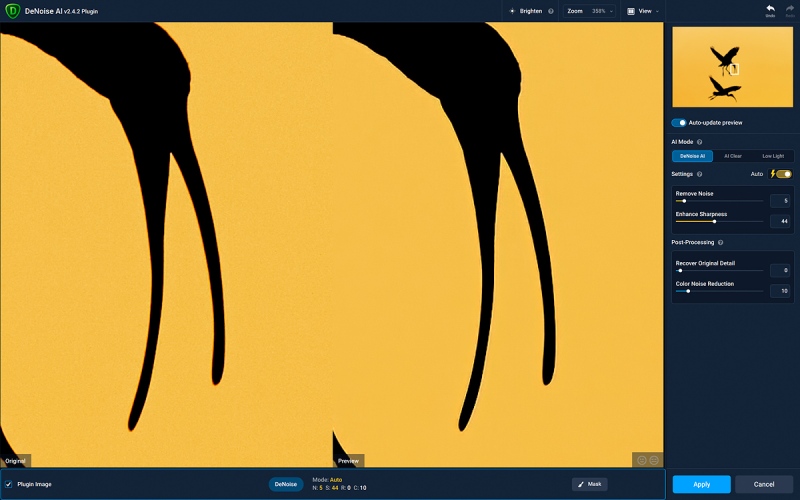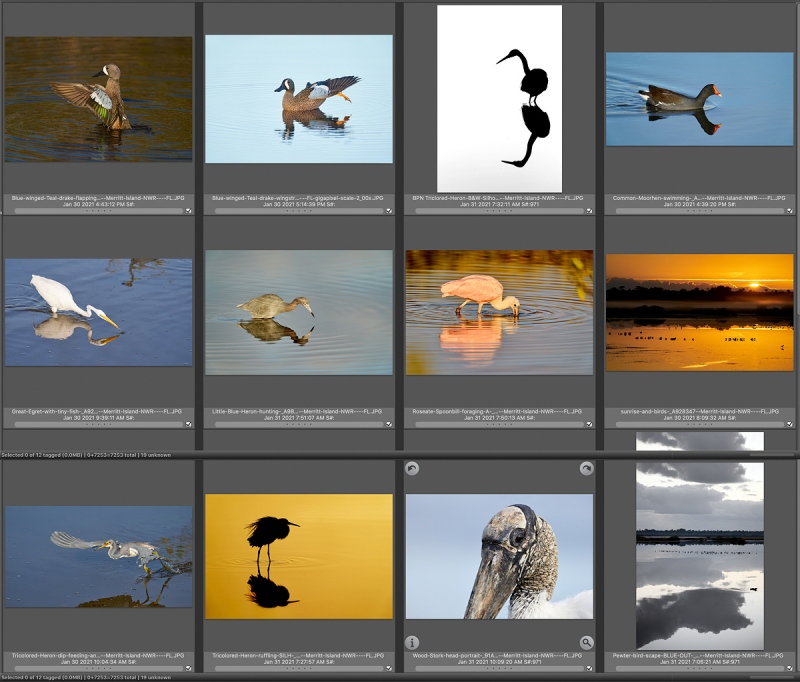March 11th, 2021 What’s Up?
I published yesterday’s blog post just after 7:00am and went to work setting up my brand new Sony Alpha a1. I thought that I had a chance to finish by 7:30am and get out to do some photography on what turned out to be a sunny morning. Though the options and set-up are very similar to the options and set-ups of the a9 ii and the a7r iv, the menus are totally different and I had a huge problem trying to assign ISO to the Control Wheel. I e-mailed several folks asking for guidance but nobody knew how to help me. (Thanks to Geoff Newhouse for trying!) Once Geoff told me that he was sure that it could be done, I went back at it with a vengeance and on about my fiftieth time, I finally figgered it out. All by my lonesome. If you got your a1 using my affiliate links from B&H or Bedfords, please shoot me your receipt via e-mail and I will send you my brief but very helpful set-up notes.
Donna Bourdon and I had a good wind for sunset, but the color faded well before the sun went down. I was set up with the 600 GM, the 2X TC, and the Alpha a1 in Tv mode with Auto ISO (as usual) and had only a few decent chances. I was incredibly impressed by the speed and sureness of the AF system; it absolutely slammed onto the birds in flight and locked on tenaciously. The AF system of the Alpha a1 is clearly better than the AF system of the a9 ii. Clearly. I will probably not have a chance to test the Bird Eye recognition at least until I get to Merritt Island. Unless I try it on Ospreys in flight tomorrow.
I am hoping to share an Alpha a1 Osprey image with you here tomorrow.
Today is Thursday 11 March 2021. The forecast for Lake Blue Cypress is for mostly sunny with light east/northeast winds, not too bad at all for Osprey flight. Wherever you are and whatever you are doing, I hope that you have a great day.
This blog post took a bit more less than one hour to prepare and makes eighty in a row with a new one. Please remember to use my B&H affiliate links or to save money at Bedfords by using the BIRDSASART discount code at checkout.
A Recent Comment by Jeff Walters
If Canon had Live Zebras would you be back full on? Or is Sony too far ahead?
My Reply
Great question Jeff. The short is is almost surely no. You’ve hit on SONY’s huge advantage: the Zebra technology. The other day while struggling with the R5’s in-viewfinder histogram, I realized something important. With the R5 you are looking at the admittedly lousy histogram — it usually misses seeing small bright highlights; if you go by the histogram, you wind up with some serious over-exposures. But the problem is that you are looking at the histogram while trying to frame the image. What I realized is that with SONY you are looking at the subject while noting the Zebras and dialing the ISO so that you have faint Zebras. The difference is that looking away from the subject with the R5 is always difficult at best, and usually fatal.
I have, however, avoided your question: would I switch back if Canon mirrorless offered Zebras with stills? The short answer is almost surely no. First off, AF with the a9 ii and the 600 GM with the 2X TC is insane. The best Canon might do with the R5/RF 2X TC, 600 III Is hope to tie. Another consideration is that I was unceremoniously (an inexplicably) let go as a Canon Explorer of Light about eight years ago. Huge thanks to program founder Michael Newler (aka Captain Explorer), the late Dave Metz, and Steve Inglima, for their (and Canon’s) incredible generosity over an eighteen year period. I did, and ironically, continue to do a ton for Canon; in recent months alone I have sold something like 51 R5 bodies via BAA affiliate link. I opted to take the high road when I was let go, and do not regret that. But it would be hard to imagine going back. Just because.
Don’t get me wrong, Canon has a better lens line-up by far, and the RF 100-500 is an absolute gem of a lens. I am baffled when folks e-mail complaining about the 1-5. In addition, the R5 with an adapter does extremely well on the fast EF super-telephoto lenses. On the other hand I have tried to become a SONY Artisan and my efforts have been pretty much ignored despite the fact that the number of Artisans who photograph birds is zero. As I (and Byron Katie) say often, You gotta love it.
Speaking of SONY, I took my brand new Sony Alpha a1 out for a test drive last night at sunset and was mega-impressed. I did not however, have a chance to play with the new Bird Eye recognition technology. Donna and I are headed for Lake Blue Cypress to meet up with Clemens Van der Werf and his boat to photograph Osprey. I am bringing only my SONY 600 GM, the 1.4X TC, and the Alpha a1. I will be shooting two systems for at least a while as the R5/RF100-500 with RF Extenders 1.4X and 2X TC are utterly superb for close work with tame birds. Time will tell how the Bird Eye recognition stuff stacks up against the R5’s Face Detection plus racking with animal eye.
Why No Photo in This Blog Post?
Donna got to ILE at about 3:00pm. At 3:30 we began setting up her brand new R5. We worked off and on for about an hour. Donna did not have a UHS ii card for her new body so I took the brand new Delkin UHS-II 128GB Power SD Memory Card out of my a1 and gave it to her. Now needing a card for my new camera, I figured what the heck so I opened the packet with one of my two brand new Sony 160GB CFexpress Type A TOUGH Memory Card, the super-fast card designed to maximize performance with the a1. I was smart enough to set up the a1 to shoot Compressed RAW as I need to find out how to convert the a1 raw files. But I was not smart enough to realize that I did not have a card reader that I could use to get the images onto my MacBook Pro. Duh. I had lots of other Delkin UHS-II cards that I could have used …
I will use a much slower UH-S II card all day today. Steve Elkins of Bedfords is sending me a ProGrade Digital CFexpress Type A & UHS-II SDXC Dual-Slot USB 3.2 Gen 2 Card Reader ($79.99) via Fed-Ex; it should arrive today or tomorrow the latest. That saves you $40.00 as compared to the cost of the Sony MRW-G2 CFexpress Type A/SD Memory Card Reader ($119.99) which is very hard to get right now. Right now, it looks as if Bedfords has both card readers in stock.
All of the links to the SONY stuff above go to Bedfords, so if you need a CFexpress Type A card and one of the readers to pair with your new Sony Alpha a1, be sure to enter the BIRDSASART code at checkout to save 3% and enjoy free second-day air shipping.
Tomorrow morning we are doing Stick Marsh over near Vero on Clemens boat. We head over to Merritt Island on Saturday to get in an extra day of shooting before the IPT begins.
Notes: It is likely that Delkin will — at some point, be making the CFexpress Type A cards. When that happens, I will switch to the Delkin cards. (I did have a problem with the single SONY Tough UHS-II card that I purchased in a pinch a while back …)
CEA-G Series CFexpress Type A Memory Card
Extremely fast, reliable, and compact for professionals who require the highest performance in the most extreme conditions. The CEA-G80T and CEA-G160G memory cards protect recordings and boost workflow for photographers, videographers, and enthusiasts.
CEA-G Series CFexpress Type A Memory Card
New standard for compact storage
CFexpress Type A cards are a new standard for compact, high-performance storage. Despite being smaller than a conventional SD card, their PCIe Gen3 interface offers ultra-fast data transfer. It is an ideal storage medium for the future of compact, high-bitrate video and still cameras.
High-speed performance
Sony CFexpress Type A memory cards are designed for professional photographers, videographers, and enthusiasts looking to super-charge their workflow with unrivaled speed and reliability. Ultra-high-speed performance (up to 800 MB/s read and 700 MB/s write ) is efficiently packed in the compact and durable body, to help you get the most from the latest high-end cameras.
Made incredibly TOUGH
Thanks to Sony’s unique TOUGH card design, our CFexpress Type A cards offer over 10x greater bend resistance than the CFexpress Type A standard. Designed for absolute dependability, the resin body is 5x more impact-resistant than the CFexpress Type A standard, and provides IP57 dust and water protection. New heat-dissipating materials also ensure consistent high-speed data transfers, along with resistance to X-rays, UV, and electrostatic radiation.
Work faster, be more productive
CFexpress Type A memory cards open up worlds of opportunity for professionals. Handling high-resolution files and high-speed recordings in a small but rugged format, it’s perfect for speeding up workflows and improving productivity, allowing you to have more time available for creative work.
Rapid-response photography
Dramatically expand your photographic possibilities, with uncompressed continuous RAW shooting for fast-moving action such as motor sports and wildlife. Writing speeds of up to 700 MB/s1 ensure ultra-fast camera buffer clearance for responsive, continuous shooting.
Dependable videography
Sony CFexpress Type A cards are optimized for continuous, high-bandwidth data writing, making them ideal for professional high-bitrate video recording, such as 4K 120p, where dependability is critical. For extra reassurance and video recording stability they also carry the VPG (Video Performance Guarantee) 400.
Speed up workflow with the CFexpress Type A card reader
Optimized for Sony CFexpress Type A memory cards, the optional MRW-G2 card reader allows you to transfer data via a SuperSpeed USB 10 Gbps (USB 3.2) interface and take full advantage of high-speed backups and more efficient workflows. It’s compact, easy to carry, and works with both Sony CFexpress Type A and SDXC UHS-II/UHS-I memory cards.
Sony’s TOUGH for the roughest places
With a tough design, CFexpress Type A memory cards offer superior strength up to 10x greater than the CFexpress Type A standard, additional rigidity tested to 150 newtons of force, and can withstand falls of up to 24.6 feet.
Sony’s TOUGH for the toughest places
You can rely on CFexpress Type A memory cards to work faultlessly in extreme temperatures, X-rays, electrostatic environments, and intense UV light. A dust- and water-resistant design provides the reliability needed for outdoor use in challenging conditions (IP57).
File Rescue: Recover lost files
New and Better Bedfords Discount Policy!
You can now save 3% on all of your Bedfords photo gear purchases by entering the BIRDSASART coupon code at checkout. Your discount will be applied to your pre-tax total. In addition, by using the code you will get 2nd day air shipping via Fed Ex.
Grab a Nikon AF-S Teleconverter TC-14E III and save $14.99. Purchase a Canon EOS R5 and your discount will be $116.97. Purchase a Sony FE 600mm f/4 GM OSS lens and save a remarkable $389.94! Your Bedford’s purchase no longer needs to be greater than $1,000.00 for you to receive a discount. The more you spend, the more you save.
Money Saving Reminder
Many have learned that if you need a hot photo item that is out of stock at B&H and would enjoy free second-day air shipping, your best bet is to click here, place an order with Bedfords, and enter the coupon code BIRDSASART at checkout. If an item is out of stock, contact Steve Elkins via e-mail or on his cell phone at (479) 381-2592 (Central time). Be sure to mention the BIRDSASART coupon code and use it for your online order to save 3% and enjoy free 2nd-day air shipping. Steve has been great at getting folks the hot items that are out of stock at B&H and everywhere else. The wait lists at the big stores can be a year or longer for the hard to get items. Steve will surely get you your gear long before that. For the past year, he has been helping BAA Blog folks get their hands on items like the SONY a9 ii, the SONY 200-600 G OSS lens, the Canon EOS R5, the Canon RF 100-500mm lens, and the Nikon 500mm PF. Steve is personable, helpful, and eager to please.
March 10th, 2021
But Don’t Get Too, Too Excited!
In today’s post you will see some astounding images made at 1000mm with the hand held Canon RF 100-500mm f/4.5-7.1L IS USM lens with the Canon Extender RF 2x and the highly touted 45MP Canon EOS R5 Mirrorless Digital camera body.
But don’t get too, too excited:
1- You will likely need fairly fast shutter speeds in order to create sharp images.
2- You will be working at very small apertures — wide open at 1000mm is f/14 — that will require relatively high ISO settings in any lighting conditions other than full sun.
3- As seen by the two screen captures above, framing an image properly when hand holding at 1000mm (20X magnification) is extremely difficult. That is true even when the bird is completely still like the Laughing Gull was when the image on the left (above) was created. If a bird is moving in any way, framing becomes close to impossible; the Whimbrel (above, on the right), walked right in front of me. I was a bit too greedy and as a result, did not make a single image without clipping the bill tip. (I do have a plan for repairing the Whimbrel image; if I succeed you will be seeing the result here on the blog at some point.
What’s Up?
On Tuesday morning, I spotted the last surviving baby crane (of the four hatched this season) in the South Marsh with the two adults. It is apparently doing very well. I made a few nice images of an adult crane ruffling in soft light and then headed home early.
I decided to do a Camtasia video gallery presentation for the BAA Canon R5 Camera User’s e-guide. It took me less than an hour to record it, more than two hours to edit and render it for sharing, and more than three hours to upload it. Though sunset looked somewhat promising I opted to stay home and keep working. There is tons going on.
Multiple-IPT veteran and dear friend Donna Bourdon is flying from Memphis to Orlando today for three days of In-the-Field Instruction and help with her brand new R5 (that is presently sitting on my dining room table). Jim will be picking Donna up after lunch. We are hoping for a decent sunset shoot.
As the baby crane photography has fizzled with the loss of the two colts and the one chick, BAA-friend Clemens Van der Werf is driving up from West Palm with his boat in tow. We plan on meeting him and Lake Blue Cypress on Thursday morning. Donna’s partner Bev Still will meet us at my home on Saturday and the three of use will be heading over to Titusville for the Merritt Island IPT.
In addition to the video gallery, I got more work done on the R5 guide. Bruce Dudek continues to be an amazing help and resource despite that fact that he keeps asking pointed questions and making suggestions that require complete re-writes of major portions of the guide. For that I thank him.
Right now, the battery for my new SONY Alpha a-1 mirrorless camera body is on the charger. A good bit of news is that it takes the same battery as the a9/a7r series bodies. It is 6:29am as I type. If I can get this blog done and posted, I hope to have a few minutes for a cursory set-up of the a1 and head down to the lake for a bit before returning home to work on the R5 guide.
Please do not ask me my opinion of folks who constantly whine, I have nothing to do!
Today is Wednesday 10 March 2021. The forecast for this morning is for partly cloudy skies with gentle winds from the east/northeast. Wherever you are and whatever you are doing, I hope that you have a great day.
This blog post took a bit more than two hours to prepare and makes seventy-nine days in a row with a new one. Please remember to use my B&H affiliate links or to save money at Bedfords by using the BIRDSASART discount code at checkout.
The BAA Used Gear Page
The Used Gear page continues to be very active. The BAA Used Gear Page is the place to sell your used photographic equipment. We will help you to get your gear sold quickly for 30 to 70% or more than what the big guys are offering … Doubt me? Check out the Recent Sales list at the bottom of the page.
Canon EF 500 f4/L IS II USM Lens
Kirk Stitt is offering a Canon EF 500 f4/L IS II USM lens in excellent plus condition for a very low $5349.00. The sale includes a LensCoat, the rear lens cap, the lens trunk, the front lens cover, the lens strap, and insured ground shipping via major courier to lower-48 US addresses only. Your item will not ship until your check clears unless other arrangements are made.
Please contact Kirk Stitt via e-mail or by phone at 1-900-800-9898 (Mountain time zone).
With the success of the Canon EOS R5 and R6 mirrorless bodies, the series II super-teles are in high demand. The 500 f/4 super-telephotos have long been the world’s most popular lenses for birds, nature, wildlife, and sports for many decades. Canon’s Series II version is light, fast, super-sharp, and produces amazing images with both the 1.4X and 2X III TCs. The 500 II is relatively small, easily hand-holdable for some folks, and is much easier to travel with, focuses closer than, and costs a lot less than the 600 II or the 600 III!. Lastly, and you might find this amazing, the magnification for the 500 II is the same as it is for the 600 II: .15X. How is that possible? Magnification is calculated at the minimum focusing distance of the lens — 12.14 feet (3.7 meters) for the 500 II and 14.77 feet (4.5 meters) for the 600 II. Simply put, the 500 II focuses more than two feet closer than the 600 II. Please do not tarry if you are seriously interested in Kirk’s lens as it should sell quickly. artie
Canon EOS R5 Camera User’s e-Guide
Eleven days ago, I sent out about a dozen copies of the almost finished Canon EOS R5 Camera User’s e-Guide for review to folks who had previously gotten free copies of the R5/R6 AF e-Guide by using my affiliate links to purchase their Canon mirrorless gear. In the same vein, I contacted everyone who purchased the R5/R6 AF e-Guide last week. More recently, folks who purchased the R5/R6 AF Guide were offered the opportunity to purchase a copy the pre-publication guide for review. Many folks have responded with thoughtful reviews, most recently, IPT veteran Warren Howe.
Because the camera and the Menus are so complex, this guide has required a ton of research, a lot of time, and a lot of effort (and will continue to do so until it is complete). It should be finished by the first week in March. 2021. The final update of the R5/R6 AF e-Guide has become part of the complete Camera User’s e-Guide; it has already been revised and expanded.
The complete Camera User’s guide will sell for $75.00. Folks who purchased their Canon gear using my links will receive a $65.00 discount; the guide will cost them a nominal $10.00. Folks who spent more than $7500.00 on Canon mirrorless gear using either of my affiliate links (B&H or Bedfords), will receive the Camera User’s e-Guide for free. Folks who purchased the R5/R6 AF e-Guide will receive a $10.00 discount on the User’s e-Guide. The best news is that the end is in sight.
New and Better Bedfords Discount Policy!
You can now save 3% on all of your Bedfords photo gear purchases by entering the BIRDSASART coupon code at checkout. Your discount will be applied to your pre-tax total. In addition, by using the code you will get 2nd day air shipping via Fed Ex.
Grab a Nikon AF-S Teleconverter TC-14E III and save $14.99. Purchase a Canon EOS R5 and your discount will be $116.97. Purchase a Sony FE 600mm f/4 GM OSS lens and save a remarkable $389.94! Your Bedford’s purchase no longer needs to be greater than $1,000.00 for you to receive a discount. The more you spend, the more you save.
Money Saving Reminder
Many have learned that if you need a hot photo item that is out of stock at B&H and would enjoy free second-day air shipping, your best bet is to click here, place an order with Bedfords, and enter the coupon code BIRDSASART at checkout. If an item is out of stock, contact Steve Elkins via e-mail or on his cell phone at (479) 381-2592 (Central time). Be sure to mention the BIRDSASART coupon code and use it for your online order to save 3% and enjoy free 2nd-day air shipping. Steve has been great at getting folks the hot items that are out of stock at B&H and everywhere else. The wait lists at the big stores can be a year or longer for the hard to get items. Steve will surely get you your gear long before that. For the past year, he has been helping BAA Blog folks get their hands on items like the SONY a9 ii, the SONY 200-600 G OSS lens, the Canon EOS R5, the Canon RF 100-500mm lens, and the Nikon 500mm PF. Steve is personable, helpful, and eager to please.


Gear Questions and Advice
Too many folks attending BAA IPTs (remember those?) and dozens of photographers whom I see in the field and on BPN, are–out of ignorance–using the wrong gear especially when it comes to tripods and more especially, tripod heads… Please know that I am always glad to answer your gear questions via e-mail. Those questions might deal with systems, camera bodies, accessories, and/or lens choices and decisions.
|
|
|
This image was created on 28 February 2021 at Fort DeSoto Park, Tierra Verde, FL. Using the knee-pod technique while seated on the wet sand, I worked with the the handheld Canon RF 100-500mm f/4.5-7.1L IS USM lens with the Canon Extender RF 2x (at 1000mm) and the highly touted 45MP Canon EOS R5 Mirrorless Digital camera body. ISO 800. Exposure determined by test exposure & histogram and blinkies evaluation: 1/800 second at f/18 (stopped down 2/3-stop) in Manual mode. RawDigger showed this one to be less than 1/3 stop under-exposed. AWB at 8:35am on a sunny morning.
Face Detection plus Tracking grabbed and tracked the gull’s eye perfectly.
Click on the image to see a larger version.
Image #1: Laughing Gull just beginning to molt into breeding plumage/head portrait
|
Thanks Steve King!
On the last day of my recent Fort DeSoto busman’s holiday, Steve King joined me for a morning of In-the-Field Instruction. We had a great day. When he mentioned that he was bringing along his Canon Extender RF 2x, I thought, Now that seems quite impractical. None-the-less, when the sun came out at about 8:15am, I asked to borrow his RF 2X and Steve kindly went to his pack and handed it over. Long story short: I ordered one from Steve Elkins the next day. Like everything R5-related, it is hard to get your hands on the RF doubler. Mine should be here Friday just before I leave for the Merritt Island IPT.
|
|
|
Face Detection plus Tracking grabbed and tracked the gull’s eye perfectly.
Click on the image to see a larger version.
Image #1A: DPP 4 screen capture for the Laughing Gull just beginning to molt into breeding plumage/head portrait image
|
Somewhat Amazingly
Somewhat amazingly, Face Detection plus Tracking AF performed superbly at f/14 even at 1000mm. With the camera set up as detailed in the nearly finished BAA Canon EOS R5 Camera User’s e-Guide, the performance of the AF system left me slack-jawed. As noted above, the huge problem was with framing the images properly. I worked with the 2X for about 30 minutes and created about 700 images. Well more than 400 of those were insta-deletes because they were horribly framed.
Note the red AF box squarely on the eye of the gull. Even in the mis-framed images that opened this blog post, the AF system nailed the eye.
|
|
Image #1B: Topaz DeNoise on the Laughing Gull just beginning to molt into breeding plumage/head portrait image
|
Topaz DeNoise AI on DeNoise on Auto
Be sure to click on the image to see the phenomenal job that DeNoise AI did on the background noise and the noise in the shadows as well. With either DeNoise or Low Light, smooth-as-a-baby’s tush results are par for the course. It will be interesting to see what happens when I try the Canon rig at 1000mm in low light conditions …
Great Topaz News!
Folks who use the BAA Topaz link to purchase Sharpen AI, DeNoise AI, or the Utility Bundle (or any other Topaz plug-ins) will receive a 15% discount by entering the ARTHUR15 code at checkout. If the stuff is on sale (as it usually is), you save 15% off of the sale price! To get the discount you must use my link and you must enter the discount code. Be sure to start with this link.
Those who purchase Sharpen AI, DeNoise AI, or any other Topaz plug-ins using my link and then entering the ARTHUR15 code at checkout can e-mail to request a short Getting Started with Topaz e-Guide. Please include a copy of your Topaz receipt that shows the discount. Aside from the basics, the guide explains how to install the plug-ins so that they appear in the Photoshop Filter Menu.
|
|
|
This image was also created on 28 February 2021 at Fort DeSoto Park, Tierra Verde, FL. Again, using the knee-pod technique while seated on the wet sand, I worked with the the handheld Canon RF 100-500mm f/4.5-7.1L IS USM lens with the Canon Extender RF 2x (at 1000mm) and the highly touted 45MP Canon EOS R5 Mirrorless Digital camera body. ISO 800. Exposure determined by test exposure & histogram and blinkies evaluation: 1/640 second at f/20 (stopped down one-stop) in Manual mode. RawDigger showed this one to be less than 1/3 stop under-exposed. AWB at 8:28am on a sunny morning.
Face Detection plus Tracking grabbed and tracked the gull’s eye perfectly.
Click on the image to see a larger version.
Image #2: Laughing Gull molting into breeding plumage/head portrait
|
Further Along
The bird in this image is a a bit further along in its molt to breeding plumage. Even when the bird began calling, the AF system had zero problems tracking the eye. Perhaps even more astoundingly, the images at 1000mm were incredibly sharp and featured the crispy eye skins that I love. And the fine-feather-detail (FFD) was off the charts.
Stopping Down?
Some might ask, Why stop down to f/18 and f20 when wide open at 1000mm is f/14? . Folks need to remember that the need for additional depth of field is greatest when you are working with long focal lengths at point blank range. At six feet at 1000mm wide open the total depth of field is 0.0 feet. At f/20 it increases to 0.01 feet. Not much but better than nothing.
|
|
|
This image was also created on 28 February 2021 at Fort DeSoto Park, Tierra Verde, FL. Again, using the knee-pod technique while seated on the wet sand, I worked with the the handheld Canon RF 100-500mm f/4.5-7.1L IS USM lens with the Canon Extender RF 2x (at 902mm) and the highly touted 45MP Canon EOS R5 Mirrorless Digital camera body. ISO 800. Exposure determined by test exposure & histogram and blinkies evaluation: 1/640 second at f/20 (stopped down one-stop) in Manual mode. RawDigger showed this one to be less than 1/3 stop under-exposed. AWB at 8:24am on a sunny morning.
Face Detection plus Tracking grabbed and tracked the gull’s eye perfectly.
Click on the image to see a larger version.
Image #3: Laughing Gull molting into breeding plumage/head portrait
|
The Whole Nine Yards
This bird is pretty much in full breeding plumage with the complete jet-black cap, wine-red bill, and white eye crescents. With blue water backgrounds, they are a sight to see. Most of the Laughing Gulls will be in full breeding plumage in April. They and the Royal and Sandwich Terns will be exhibiting a variety of breeding behaviors on both IPTs. Those include courtship displays and feeding, copulatory stands, and copulations.
Summing Up
The addition of the RF 2X teleconverter to the R5/RF 100-500/RF 1.4X teleconverter greatly expands the versatility of the already great Canon mirrorless rig. As with the RF 1.4X TC, you cannot zoom wider than the 300mm mark. That gives you a hand holdable 600-1000mm lens that is super-sharp and offers incredible AF (albeit with small apertures with correspondingly high ISOs.
Do note that you mount the TC you must be at the 300mm setting (or longer).
|
|
|
All of the images were created at Fort DeSoto in April or early May. Click on the card to enjoy a larger version.
Fort DeSoto IPT card A
|
Fort DeSoto Spring IPT #1
Fort DeSoto Spring IPT #1. 3 1/2 DAYS. SAT 10 APR thru the morning session on TEUS 13 APR 2021. $1499 includes three lunches. Limit: 6. Openings 5.
While DeSoto is one of the rare photo hotspots with the potential to be great any day of the year, it absolutely shines in spring. Many of the wading birds and shorebirds are in full breeding plumage. The terns and gulls are courting and copulating. We will have lots of flight photography opportunities. Did I mention that many of the birds are silly tame?
A $499 deposit is required to hold your spot for this IPT. You can send a check (made out to “BIRDS AS ART) to us here: BIRDS AS ART, PO Box 7245, Indian Lake Estates, FL, 33855, or call Jim or Jennifer at the office with a credit card at 863-692-0906. Your balance, payable only by check, is due immediately after you sign up. If you have any questions, please feel free to contact me via e-mail. If you cancel due to COVID 19 concerns, all of your payments will be refunded.
|
|
|
All of the images were created at Fort DeSoto in April or early May. Click on the card to enjoy a larger version.
Fort DeSoto IPT card B
|
Fort DeSoto Spring IPT #2
Fort DeSoto Spring IPT #2. 3 1/2 DAYS. MON 26 APR thru the morning session on THURS 29 APR 2021. $1499 includes three lunches. Limit: 6/Openings: 5.
Not only am I conversant in all three major camera systems used in the US — Nikon, Canon, and SONY (sorry Andy Rouse …), I have used all three within the past four years. Those include both SONY and Canon mirrorless. On both of these IPTs you will learn how to get the best exposure, how to get the most out of your AF system, and how to get close to free and wild birds. And tons more.
A $499 deposit is required to hold your spot for this IPT. You can send a check (made out to “BIRDS AS ART) to us here: BIRDS AS ART, PO Box 7245, Indian Lake Estates, FL, 33855, or call Jim or Jennifer at the office with a credit card at 863-692-0906. Your balance, payable only by check, is due immediately after you sign up. If you have any questions, please feel free to contact me via e-mail. If you cancel due to COVID 19 concerns, all of your payments will be refunded.
|
|
|
All of the images were created at Fort DeSoto in April or early May. Click on the card to enjoy a larger version.
Fort DeSoto IPT card C
|
Fort DeSoto Spring IPTs Expected Species
With any luck, we should get to photograph the following species: Laughing, Ring-billed, Herring, and Lesser Black-backed Gull; Royal, Sandwich, and Forster’s Tern: Great, Snowy, and white and dark morph Reddish Egret and Great Blue, Little Blue, and Tricolored Heron; Yellow-crowned Night-Heron, Wood Stork, Roseate Spoonbill, and Brown Pelican. We will see and photograph lots of shorebirds including American Oystercatcher, Black-bellied, Wilson’s, Semipalmated, Snowy, and Piping Plover, Marbled Godwit, Willet, Dunlin, Red Knot, Sanderling, and Western and possibly White-rumped Sandpiper.
Sign up for both IPTs and enjoy a $200 discount. Most of us will be staying in nearby Gulfport.
Typos
With all blog posts, feel free to e-mail or to leave a comment regarding any typos or errors.
March 9th, 2021 What’s Up?
Monday morning provided little action, and Monday evening’s sunset was not too good at all. Well after the sun was down, I watched one young and two adult Bald Eagles cavorting over the marsh to the north. The youngster kept diving into the marsh grasses and coming up empty. It was fun to watch. I tried some blurs at shutter speeds ranging from 1/30 to 1/8 second. And deleted them all.
Again I got a ton of work done on the BAA Canon R5 Camera User’s e-Guide. As far as the text is concerned, I have a very few loose ends to tighten up. I decided to do an educational video gallery. It is not yet 5:00am as I type so once I hit publish, the plan is to do the video before I head down to the lake.
Today is Tuesday 9 March 2021. The forecast for this morning is for partly cloudy skies with gentle winds from the northeast. I will head down to the lake for a look-see early this morning.
Wherever you are and whatever you are doing, I hope that you have a great day.
This blog post took a bit more than 1 1/2 hours to prepare and makes seventy-eight days in a row with a new one. Please remember to use my B&H affiliate links or to save money at Bedfords by using the BIRDSASART discount code at checkout.
A Tough Year for Sandhill Cranes at ILE
At about 6:00pm on Sunday evening, while checking on the crane family at the south end of the South Field, I was pleased to see that both chicks were doing well and that the family had crossed back over the canal and was over-nighting on the original nest. They had been spending their nights at an unknown location in the South Marsh. When I went to check on them on Monday morning, there was only one large chick with the parents. I sat on a slope with the R5/RF 100-500 as the family foraged their way toward me. I made some nice vertical of the surviving chick as it walked right toward me. As it kept coming I turned the camera to horizontal format and made the sweetest chick head portrait ever. Because I was relatively low, the background was absolutely creamy.
When I returned 30 minutes later, I could not — though I looked everywhere — find the family. Before sunset on Monday, I returned to the location of the nest. A friend was there, and we could only find the two adults. But just before I left, I spotted the chick foraging in the thick vegetation near the nest. Whew!
With the loss of the two colts at the north end of the North Field last Wednesday evening, only a single young crane of the four hatched this season survives. One out of four is bad news. And the surviving chick has a long way to go. I wish it luck. The typical mortality rate for young cranes here at ILE has been about 50% so 2021 has indeed already been a very poor year. I am hoping that there might be a pair on a late nest as there was last year …
I have never seen so many eagles along the lakefront …
The BAA Used Gear Page
The Used Gear page continues to be very active. The BAA Used Gear Page is the place to sell your used photographic equipment. We will help you to get your gear sold quickly for 30 to 70% or more than what the big guys are offering … Doubt me? Check out the Recent Sales list at the bottom of the page.
Price Drops
Canon EOS 5D Mark III dSLR Converted to Infrared (with Extras)
Price reduced $100.00 8 MAR 2021
BIRDS AS ART friend and multiple IPT veteran Morris Herstein is offering a Canon EOS 5D Mark III dSLR converted to infrared (830 nanometers) by Life Pixel in excellent plus condition with extras for $899.00 (was $999.00). The sale include two Canon LP-E6N batteries, the charger, the front body cap, two Lexar 128GB 1066X flash cards, and insured ground shipping via major courier to lower-48 US addresses only. Your item will not ship until your check clears unless other arrangements are made.
Please contact Morris via e-mail.
When I shot Canon exclusively, I had a ton of fun making landscapes, tree-scapes, and cloud-scapes with a 5D Mark II that had been converted to infrared. The 5D III is a step up from that. These infrared-converted bodies pair well with the 24-105 and any of the 70-200s. artie
FlexShooter Pro Tripod Head
Price reduced $50.00 8 MAR 2021
BIRDS AS ART friend and multiple IPT veteran Morris Herstein is offering a barely used FlexShooter Pro head in for a BAA record-low $448.00 (was $498.00). The sale includes insured ground shipping via major courier to lower-48 US addresses only. Your item will not ship until your check clears unless other arrangements are made.
Please contact Morris via e-mail.
The FlexShooter Pro is a ballhead that thinks and acts like a gimbal head. Thanks to the bi-directional clamp, it is great for lenses short and long. Once your rig is set up properly, long lenses stay right where you point them without your having to lock up the head! Where you point the lens is what you get. That thanks to the patented counter-balanced spring system design. I predicted that these heads would take the world of nature photography by storm. And they have. They sell new for $599.00. artie
Canon EOS R5 Camera User’s e-Guide
Ten days ago, I sent out about a dozen copies of the almost finished Canon EOS R5 Camera User’s e-Guide for review to folks who had previously gotten free copies of the R5/R6 AF e-Guide by using my affiliate links to purchase their Canon mirrorless gear. In the same vein, I contacted everyone who purchased the R5/R6 AF e-Guide last week. More recently, folks who purchased the R5/R6 AF Guide were offered the opportunity to purchase a copy the pre-publication guide for review.
Because the camera and the Menus are so complex, this guide has required a ton of research, a lot of time, and a lot of effort (and will continue to do so until it is complete). It should be finished by the first week in March. 2021. The final update of the R5/R6 AF e-Guide has become part of the complete Camera User’s e-Guide; it will be revised if warranted.
The complete Camera User’s guide will sell for $75.00. Folks who purchased their Canon gear using my links will receive a $65.00 discount; the guide will cost them a nominal $10.00. Folks who spent more than $7500.00 on Canon mirrorless gear using either of my affiliate links (B&H or Bedfords), will receive the Camera User’s e-Guide for free. Folks who purchased the R5/R6 AF e-Guide will receive a $10.00 discount on the User’s e-Guide. The best news is that the end is in sight.
New and Better Bedfords Discount Policy!
You can now save 3% on all of your Bedfords photo gear purchases by entering the BIRDSASART coupon code at checkout. Your discount will be applied to your pre-tax total. In addition, by using the code you will get 2nd day air shipping via Fed Ex.
Grab a Nikon AF-S Teleconverter TC-14E III and save $14.99. Purchase a Canon EOS R5 and your discount will be $116.97. Purchase a Sony FE 600mm f/4 GM OSS lens and save a remarkable $389.94! Your Bedford’s purchase no longer needs to be greater than $1,000.00 for you to receive a discount. The more you spend, the more you save.
Money Saving Reminder
Many have learned that if you need a hot photo item that is out of stock at B&H and would enjoy free second-day air shipping, your best bet is to click here, place an order with Bedfords, and enter the coupon code BIRDSASART at checkout. If an item is out of stock, contact Steve Elkins via e-mail or on his cell phone at (479) 381-2592 (Central time). Be sure to mention the BIRDSASART coupon code and use it for your online order to save 3% and enjoy free 2nd-day air shipping. Steve has been great at getting folks the hot items that are out of stock at B&H and everywhere else. The wait lists at the big stores can be a year or longer for the hard to get items. Steve will surely get you your gear long before that. For the past year, he has been helping BAA Blog folks get their hands on items like the SONY a9 ii, the SONY 200-600 G OSS lens, the Canon EOS R5, the Canon RF 100-500mm lens, and the Nikon 500mm PF. Steve is personable, helpful, and eager to please.


Gear Questions and Advice
Too many folks attending BAA IPTs (remember those?) and dozens of photographers whom I see in the field and on BPN, are–out of ignorance–using the wrong gear especially when it comes to tripods and more especially, tripod heads… Please know that I am always glad to answer your gear questions via e-mail. Those questions might deal with systems, camera bodies, accessories, and/or lens choices and decisions.
|
|
|
This image was created on 7 March 2021 down by the lake at ILE. I used the Induro GIT 404L/Levered-clamp FlexShooter Pro-mounted Sony FE 600mm f/4 GM OSS lens, the Sony FE 2.0x Teleconverter, and the blazingly fast AF King, the Sony Alpha a9 II Mirrorless Digital camera body. ISO 4000. The exposure was determined by experience or lack thereof. Muti metering +2 stops: 1/2000 sec. at f/8 (wide open) in Shutter Priority (S) mode. Surprisingly, RawDigger showed this raw file to be more than 1 1/2 stops too dark. AWB at 6:28pm on a clear evening. Technically, this was three minutes before sunset at Lake Wales but at ILE, the sun had already disappeared behind the distant woods on the far lakeshore.
Wide AF-C was active at the moment of exposure and performed to absolute perfection by nailing focus on the upper bird.
Click on the image to see a larger version.
Image #1: White Ibis sunset squabble
|
Making Good on a Second Chance
The wind had swung to the northeast late on Wednesday afternoon and with relatively clear skies, I figured that sunset might be outstanding. It began with two Ospreys chasing each other through the color, and then another diving right through the reddish/yellow in the western sky. I pretty much fanned on the latter chance and disregarded my own oft-given advice: Don’t chimp! When I looked away from the back of the camera, my heart sank as I saw two White Ibises fighting in mid-air right in the richest colored part of the sky just above where the sun had been a minute before. Drats! I got back to paying attention and somewhat miraculously, the two birds rose from the roost to tangle again in midair. Hooray! Of the five keepers that had both birds in the frame, this was my favorite.
|
|
Image #1A: Topaz DeNoise AI on the White Ibis sunset squabble image
|
Topaz DeNoise AI
For an ISO 5000 image that was more than 1 1/2 stops too dark, there was not a whole lot of noise in the original (on our left). Be sure to click on the screen capture to view the larger version and check on the effectiveness of this amazing plug-in. DeNoise AI on DeNoise completely eliminated the noise in smooth-as-a-baby’s butt fashion. As usual, it was a close call between DeNoise and Low Light.
The lower bird was slightly behind the plane of focus, so I selected that in Photoshop using Select > Subject. Since that selected both birds, I deselected the sharp upper bird, and placed the lower bird on its own layer. Then I ran Topaz Sharpen AI on Focus on that layer. The improvement was noticeable but not dramatic.
Great Topaz News!
Folks who use the BAA Topaz link to purchase Sharpen AI, DeNoise AI, or the Utility Bundle (or any other Topaz plug-ins) will receive a 15% discount by entering the ARTHUR15 code at checkout. If the stuff is on sale (as it usually is), you save 15% off of the sale price! To get the discount you must use my link and you must enter the discount code. Be sure to start with this link.
Those who purchase Sharpen AI, DeNoise AI, or any other Topaz plug-ins using my link and then entering the ARTHUR15 code at checkout can e-mail to request a short Getting Started with Topaz e-Guide. Please include a copy of your Topaz receipt that shows the discount. Aside from the basics, the guide explains how to install the plug-ins so that they appear in the Photoshop Filter Menu.
|
|
|
All of the images (plus lots more) were created on a very short visit at the end of January. Click on the card to enjoy a larger version.
Merritt Island NWR IPT card
|
Merritt Island NWR IPT
Merritt Island NWR IPT. 3 1/2 DAYS. MON 15 MAR thru the morning session on THURS 18 MAR 2021. $1499 includes three lunches. Limit: 6. Openings: 3 1/2.
When I visited — and later lived — in Deltona, FL, I made many trips to Black Point Wildlife Drive and environs. On a recent visit, I did quite well. The birds were much tamer than I remembered. I know the place well. Early spring was always best. There are tons of ducks, and wading birds including and especially both ibises. It can be great at sunrise with large flocks of shorebirds, waterfowl, ibises, and American White Pelicans filling the skies. We should get to do lots of flight photography on the causeway. At least a few good chances with Roseate Spoonbill are possible.
A $499 deposit is required to hold your spot for this IPT. You can send a check (made out to “BIRDS AS ART) to us here: BIRDS AS ART, PO Box 7245, Indian Lake Estates, FL, 3385, or call Jim or Jennifer at the office with a credit card at 863-692-0906. Your balance, payable only by check, is due immediately after you sign up. If you have any questions, please feel free to contact me via e-mail. If you cancel due to COVID 19 concerns, all of your payments will be refunded.
Typos
With all blog posts, feel free to e-mail or to leave a comment regarding any typos or errors.
|
|


